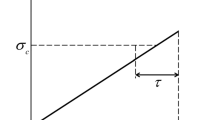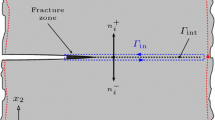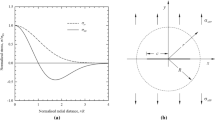Abstract
Using the criterion that a crack will extend perpendicular to the maximum circumferential stress,σ θ, we show that the directional stability of crack growth is governed by the location of microcrack initiation ahead of the crack tip. At distances greater than a geometrical radiusr o, the maximum value ofσ θ deviates from the position of symmetry. Thus, if we assume that the physical processes involved in fracture lead to crack initiation at a distancer c ahead of the crack tip, the criterion for directional stability isr o>r c. Experimental and theoretical values ofr o verify that, asr o becomes small, the crack's directional stability deteriorates.
Observing that a lengthwise compressive stress increasesr o, a center-cracked specimen was developed which allows the application of controlled lengthwise compression independently of the opening-mode load. A detailed photoelastic analysis of the specimen has provided the value ofr o as a function of the crack length. The value ofr o is then compared with the expected microcrack initiation distances in ductile fracture.
By applying sufficient lengthwise compression, we are able to make the crack grow straight and obtain numerous data points from this specimen which would otherwise be directionally unstable. The results indicate that, as the total lengthwise tensile stress at the crack tip increases, the fracture toughness also increases. Using this information we can then adjustK Ic for zero lengthwise loading and obtain a geometry independent fracture toughness.
Similar content being viewed by others
Abbreviations
- A 2 :
-
constant second term of crack-tip stress series (Pa)
- CCS :
-
center-crack specimen
- CT :
-
compact tension
- DCB :
-
double-cantilever beam
- K 1 :
-
stress-intensity factors for Mode I loading. Singularity term of crack-tip stress-series solution (MPa-m1/2)
- Q(θ f):
-
function ofθ f for photoelastic use
- r, θ:
-
polar-coordinate system centered at crack tip. Direction of crack propagation along θ=0 deg
- r c :
-
critical distance in front of the crack tip where crack initiation occurs (m)
- r f :
-
photoelastic-fringe radius (m)
- r o :
-
maximum radius for which the maximumθ f lies on θ=0 deg (m)
- θ f :
-
photoelastic-fringe angle for (∂τm)/(∂θ)=0
- σ r,σ θ,τ θ :
-
crack-tip stresses referred to polar-coordinate system (Pa)
- τ m :
-
maximum shear stress for a given point (Pa)
References
Berry, J.P., “Determination of Fracture Surface Energies by the Cleavage Technique,”J. Appl. Phys.,34,62–68 (Jan. 1963).
Kirkwood, W.F. and Prado, M.E., “Three Dimensional Stress Distribution of a Double-Cantilever Beam with a Side Notch,” Cracks and Fracture, ASTM 601, 262–273 (1976).
Benbow, J.J. andRoesler, F.C., “Experiments on Controlled Fractures,”Proc. Phys. Soc. (London),70,Ser. B.,201–211 (1957).
Saith, A., “On The Stability and Arrest of Cracks,”Ph.D. Thesis, University of California, Berkeley, CA (1971).
Kibler, J.J. and Roberts, R., “The Effect of Biaxial Stresses on Fatigue and Fracture,” ASME Trans. J. of Engin. Ind., 727–734 (1970).
Erdogan, F. andSih, G.C., “On the Crack Extension in Plates Under Plane Loading and Transverse Shear,”J. Basic Eng., Trans. ASME,85,Ser. D.,519–527 (Dec. 1963).
Williams, J.G. andEwing, P.D., “Fracture Under Complex Stress-The Angled Crack Problem,”Int. J. Fract. Mech.,8 (4),441–446 (Dec. 1972).
Finnie, I. andSaith, A., “A Note on the Angled Crack Problem and the Directional Stability of Cracks,”Int. J. of Fract.,9,484–486 (1973).
Rice, J.R. and Johnson, M.A., “The Role of Large Crack Tip Geometry Change in Plane Strain Fracture,” In Elastic Behavior of Solids, McGraw-Hill, 641–672 (1970).
Richie, R.O., Knott, J.F. andRice, J.R., “On the Relationship Between Critical Tensile Stress and Fracture Toughness in Mild Steel,”J. Mech. Phys. Solids,21,395–410 (1973).
Irwin, G.R., “Analysis of Stresses and Strains Near the End of a Crack Traversing a Plate,”J. Appl. Mech.,24 (3),361–364 (1957).
Creager, M. andParis, P., “Elastic Field Equations for Blunt Crack with Reference to Stress Corrosion Cracking,”Int. J. Fract.,3 (4),247–251 (1967).
Larsson, S.G. andCarlsson, A.J., “Influence of Non-Singular Stress Terms and Specimen Geometry on Small Scale Yielding at the Crack Tip in Elastic-Plastic Materials,”J. Mech. Phys. Solids,21,263–277 (1973).
Perra, M.W. andFinnie, I., “Fracture Toughness of a High Strength Beryllium at Room Temperature and 300 C Degrees,”J. of Matls. Science,12,1519–1526 (1977).
Nelson, F.G., Schilling, P.E. andKaufman, J.G., “The Effect of Specimen Size on the Results of Plane-Strain Fracture-Toughness Tests,”Engin. Fract. Mech.,4,33–50 (1972).
McCabe, D.E., “Evaluation of the Compact Tension Specimen for Determining Plane Strain Fracture Toughness of High Strength Materials,”J. of Matls.,7 (4),449–454 (Dec. 1972).
Author information
Authors and Affiliations
Rights and permissions
About this article
Cite this article
Streit, R., Finnie, I. An experimental investigation of crack-path directional stability. Experimental Mechanics 20, 17–23 (1980). https://doi.org/10.1007/BF02324422
Received:
Revised:
Issue Date:
DOI: https://doi.org/10.1007/BF02324422




